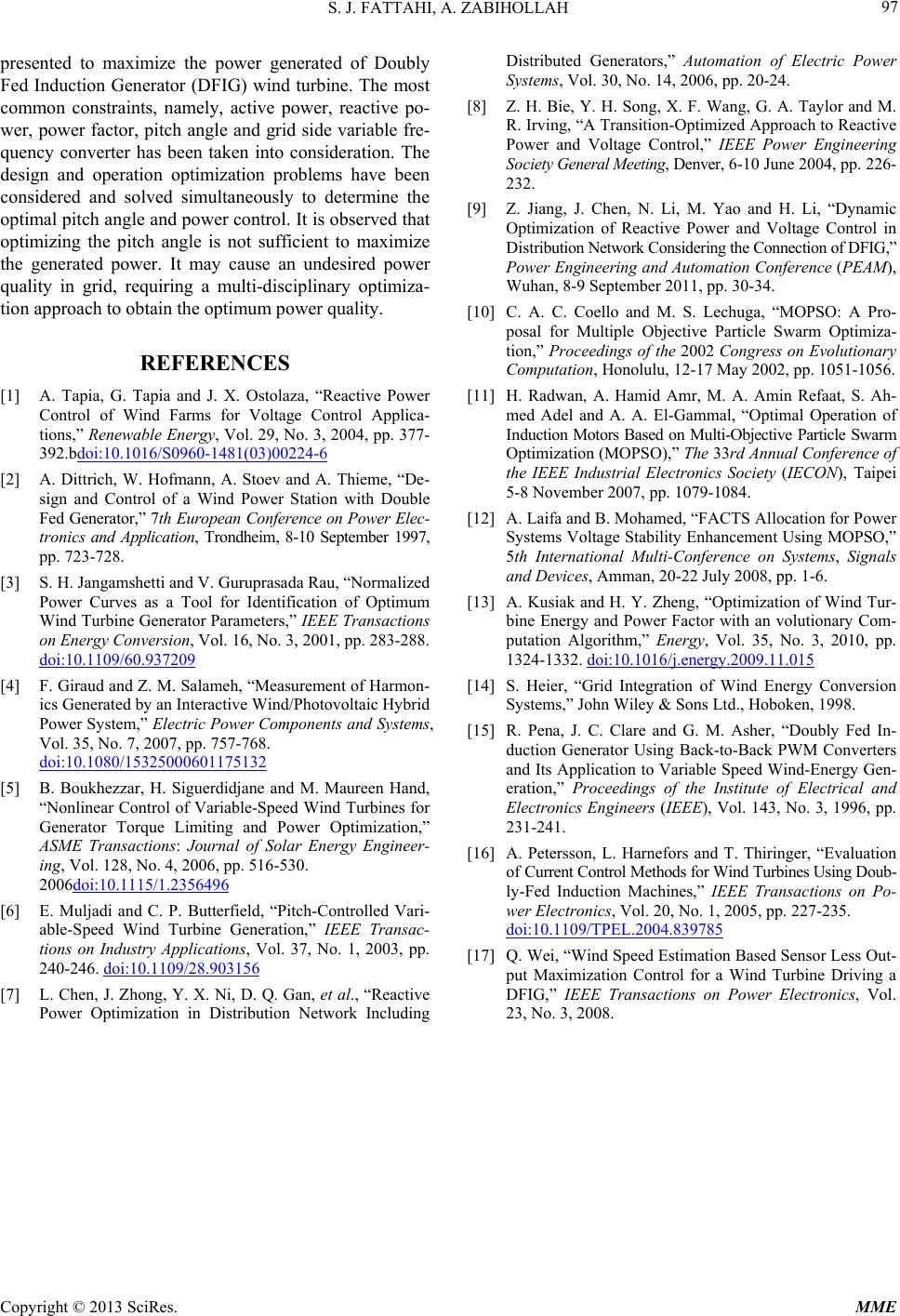
S. J. FATTAHI, A. ZABIHOLLAH
Copyright © 2013 SciRes. MME
97
presented to maximize the power generated of Do
Fed Induction Generator (DFIG) wind turbine. The most
common constraints, namely, active power, reactive po-
wer, power factor, pitch angle and grid side variable
quency converter has been taken into consideration.
design and operation optimization problems have been
considered and solved simultaneously to determine the
optimal pitch angle and power control. It is observed
optimizing the pitch angle is not sufficient to maxi
the generated power. It may cause an undesired power
quality in grid, requiring a multi-disciplinary optimiza-
tion approach to obtain the optimum power quality.
ubly
fre-
The
that
mize
REFERENCES
[1] A. Tapia, G. Tapia and J. X. Ostolaza, “Reactive Power
Control of Wind Farms for Voltage Control Applica-
tions,” Renewable Energy, Vol. 29, No. 3, 2004, pp. 377-
392.bdoi:10.1016/S0960-1481(03)00224-6
[2] A. Dittrich, W. Hofmann, A. Stoev and A. Thieme, “De-
sign and Control of a Wind Power Station with Double
Fed Generator,” 7th European Conference on Power Elec-
tronics and Application, Trondheim, 8-10 September 1997,
pp. 723-728.
[3] S. H. Jangamshetti and V. Guruprasada Rau, “Normalized
Power Curves as a Tool for Identification of Optimum
Wind Turbine Generator Parameters,” IEEE Transactions
on Energy Conversion, Vol. 16, No. 3, 2001, pp. 283-288.
doi:10.1109/60
.937209
[4] F. Giraud and Z. M. Salameh, “Measurement of Harmon-
ics Generated by an Interactive Wind/Photovoltaic Hybrid
Power System,” Electric Power Components and Systems,
Vol. 35, No. 7, 2007, pp. 757-768.
doi:10.1080/15325000601175132
[5] B. Boukhezzar, H. Siguerdidjane and M. Maureen Hand,
“Nonlinear Control of Variable-Speed Wind Turbines for
Generator Torque Limiting and Power Optimization,”
ASME Transactions: Journal of Solar Energy Engineer-
ing, Vol. 128, No. 4, 2006, pp. 516-530.
2006doi:10.1115/1.2356496
[6] E. Muljadi and C. P. Butterfield, “Pitch-Controlled Vari-
able-Speed Wind Turbine Generation,” IEEE Transac-
tions on Industry Applications, Vol. 37, No. 1, 2003, pp.
240-246. doi:10.1109/28.903156
to Reactive
Li, “Dynamic
C. Coello and M. S. Lechuga, “MOPSO: A Pro-
al Operation of
n volutionary Com-
[7] L. Chen, J. Zhong, Y. X. Ni, D. Q. Gan, et al., “Reactive
Power Optimization in Distribution Network Including
Distributed Generators,” Automation of Electric Power
Systems, Vol. 30, No. 14, 2006, pp. 20-24.
[8] Z. H. Bie, Y. H. Song, X. F. Wang, G. A. Taylor and M.
R. Irving, “A Transition-Optimized Approach
Power and Voltage Control,” IEEE Power Engineering
Society General Meeting, Denver, 6-10 June 2004, pp. 226-
232.
[9] Z. Jiang, J. Chen, N. Li, M. Yao and H.
Optimization of Reactive Power and Voltage Control in
Distribution Network Considering the Connection of DFIG,”
Power Engineering and Automation Conference (PEAM),
Wuhan, 8-9 September 2011, pp. 30-34.
[10] C. A.
posal for Multiple Objective Particle Swarm Optimiza-
tion,” Proceedings of the 2002 Congress on Evolutionary
Computation, Honolulu, 12-17 May 2002, pp. 1051-1056.
[11] H. Radwan, A. Hamid Amr, M. A. Amin Refaat, S. Ah-
med Adel and A. A. El-Gammal, “Optim
Induction Motors Based on Multi-Objective Particle Swarm
Optimization (MOPSO),” The 33rd Annual Conference of
the IEEE Industrial Electronics Society (IECON), Taipei
5-8 November 2007, pp. 1079-1084.
[12] A. Laifa and B. Mohamed, “FACTS Allocation for Power
Systems Voltage Stability Enhancement Using MOPSO,”
5th International Multi-Conference on Systems, Signals
and Devices, Amman, 20-22 July 2008, pp. 1-6.
[13] A. Kusiak and H. Y. Zheng, “Optimization of Wind Tur-
bine Energy and Power Factor with a
putation Algorithm,” Energy, Vol. 35, No. 3, 2010, pp.
1324-1332. doi:10.1016/j.energy.2009.11.015
[14] S. Heier, “Grid Integration of Wind Energy Conversion
Systems,” John Wiley & Sons Ltd., Hoboken, 1998.
trical and
[15] R. Pena, J. C. Clare and G. M. Asher, “Doubly Fed In-
duction Generator Using Back-to-Back PWM Converters
and Its Application to Variable Speed Wind-Energy Gen-
eration,” Proceedings of the Institute of Elec
Electronics Engineers (IEEE), Vol. 143, No. 3, 1996, pp.
231-241.
[16] A. Petersson, L. Harnefors and T. Thiringer, “Evaluation
of Current Control Methods for Wind Turbines Using Doub-
ly-Fed Induction Machines,” IEEE Transactions on Po-
wer Electronics, Vol. 20, No. 1, 2005, pp. 227-235.
doi:10.1109/TPEL.2004.839785
[17] Q. Wei, “Wind Speed Estimation Based Sensor Less Out-
put Maximization Control for a Wind Turbine Driving a
DFIG,” IEEE Transactions on Power Electronics, Vol.
23, No. 3, 2008.